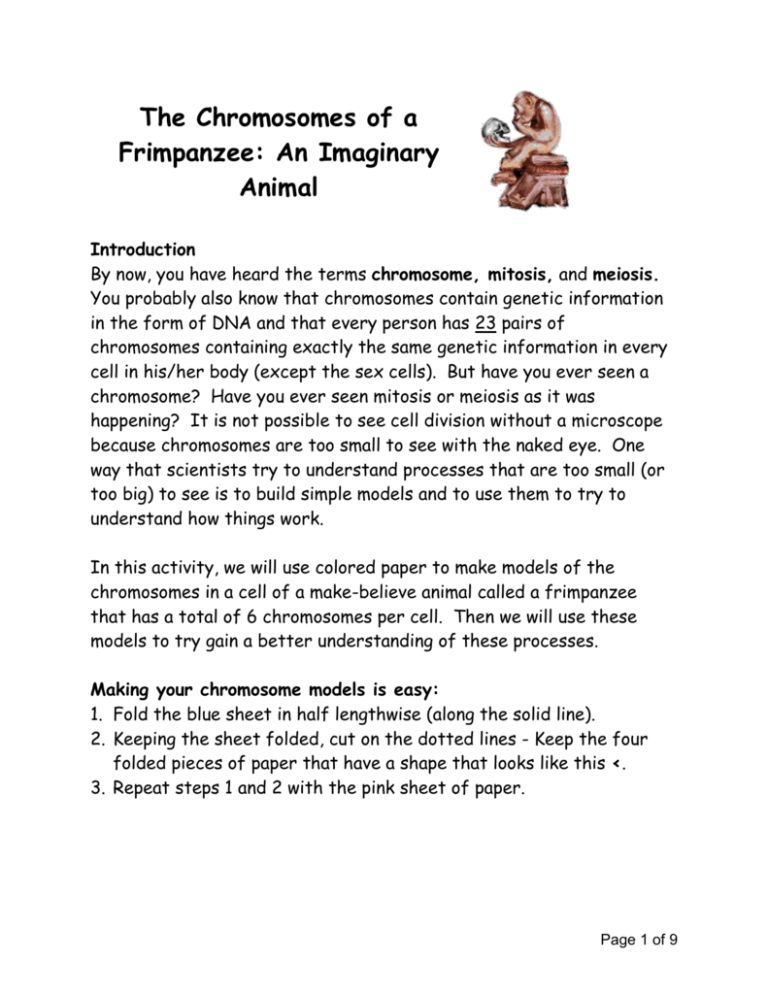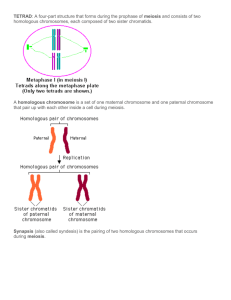The Chromosomes of a Frimpanzee: An Imaginary Animal
advertisement

The Chromosomes of a Frimpanzee: An Imaginary Animal Introduction By now, you have heard the terms chromosome, mitosis, and meiosis. You probably also know that chromosomes contain genetic information in the form of DNA and that every person has 23 pairs of chromosomes containing exactly the same genetic information in every cell in his/her body (except the sex cells). But have you ever seen a chromosome? Have you ever seen mitosis or meiosis as it was happening? It is not possible to see cell division without a microscope because chromosomes are too small to see with the naked eye. One way that scientists try to understand processes that are too small (or too big) to see is to build simple models and to use them to try to understand how things work. In this activity, we will use colored paper to make models of the chromosomes in a cell of a make-believe animal called a frimpanzee that has a total of 6 chromosomes per cell. Then we will use these models to try gain a better understanding of these processes. Making your chromosome models is easy: 1. Fold the blue sheet in half lengthwise (along the solid line). 2. Keeping the sheet folded, cut on the dotted lines - Keep the four folded pieces of paper that have a shape that looks like this <. 3. Repeat steps 1 and 2 with the pink sheet of paper. Page 1 of 9 You should end up with 6 pieces of paper that have the < shape. For now, keep them folded! These are the chromosomes in a normal frimpanzee cell. Trace the outline of your set of chromosomes in the space below. Be sure to label the size ( small, medium, large), shape, number, and colors of the chromosomes. Chromosome Drawings Page 2 of 9 What happens during interphase? With your models folded, you are looking at chromatids, not chromosomes. A chromosome is actually two identical chromatids joined together at the center by a structure called the centromere. Before mitosis or meiosis can occur, the DNA making up the chromatid must be copied. This happens during a phase in the cell cycle called interphase. Many other things happen during interphase such as cell growth and formation of some organelles. INTERPHASE 1. Unfold all of your chromosomes so that the model looks like an X. The unfolding represents the copying of the DNA in the chromatid. Notice that the two sides of the X are identical. 2. Draw a circle in the center of each chromosome to represent the centromere. 3. Wrap your chromosomes in yarn. This represents the nuclear membrane. Also use another strand of yarn to make the cell membrane. MAKE IT LARGE!!!! Modeling Meiosis Now that we understand something about mitosis, let’s consider meiosis. First of all, why do you think some of the chromosomes are blue and some are pink? Frimpanzees are animals and each frimpanzee has a mother and a father. When frimpanzee males mate with frimpanzee females, a sperm cell from the father joins an egg cell from the father. The sperm cell from the father and the egg cell from the mother both contain DNA in the form of chromosomes. They join together and their chromosomes mix in an embryo cell which will eventually become a baby frimpanzee (after a great deal of mitosis!). In our model, the Page 3 of 9 chromosomes that are blue have come from the father frimpanzee, while the chromosomes that are pink have come from the mother frimpanzee. Now let’s model the steps of meiosis... 1. Interphase – Your chromosomes are inside of the nuclear membrane. MEIOSIS I 2. Prophase I - Chromosomes become visible (under a microscope!). Homologous chromosomes move towards each other. Homologous chromosomes are chromosomes of the same size that contain the same kind of genes. One of the homologous chromosomes comes from each parent. 3. Metaphase I - Homologous chromosomes line up on the equator. Note that not the blue and the pink chromosomes do not always have to be on the same side of the equator when the pairs move to the center. 4. Anaphase I - Homologous chromosomes separate and move to opposite sides of the cell. 5. Telophase I Two new nuclei form 6. Cytokinesis- Two new cells form. Page 4 of 9 MEIOSIS II - This will be a separate process in each of the two new cells. Each of your cells will go through the next phases. 7. Prophase II - Chromosomes become visible (under a microscope). 8. Metaphase II - Chromosomes line up at the equator. 9. Anaphase II - Chromosomes split at centromere (you will have to use your scissors during this step) and the individual chromatids get moved to opposite ends of the cell. 10. Telophase II and Cytokinesis - The cells split and a total of four new cells are formed. These cells are called gametes they are the sex cells that will become either frimpanzee sperm or egg cells. QUESTIONS 1. How many chromatids are in each of the new cells? 2. Each of the chromatids is either large, medium or small, and either blue or pink. Describe each of the chromatids in each of the new cells: chromatid 1 chromatid 2 chromatid 3 Cell 1: Cell 2: Cell 3: Cell 4: Page 5 of 9 3. Is the combination of chromatids the same in all four of the cells? 4. Compare the combination of chromatids with your picture and description on page 1. How does the number and combination of chromatids in the frimpanzee cells after meiosis compare with the number and combination of chromatids in the original frimpanzee cells? 5. Compare your results with those of another group - did they get the same combinations of chromatids? Did they start with the same combinations of chromatids (compare your pictures on page 1). 6. Cells resulting from mitosis all have the same chromatids as the original cell, but cells resulting from have different combinations of chromatids. During which phase of meiosis does this difference start to occur? 7. Fill in the Chart on the next page. Draw a picture of the cell in each stage of meiosis as seen with your chromosomes. Also write down 2 observations of each stage. You should have 10 stages. Stages 6-9 should have 2 cells in each box. Page 6 of 9 Stages of Meiosis 1. 2. 3. 4. 5. 6. 7. 8. 9. 10. Page 7 of 9 Photocopy on BLUE paper. Page 8 of 9 Photocopy on PINK Paper Page 9 of 9








